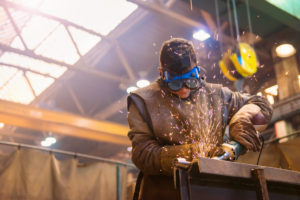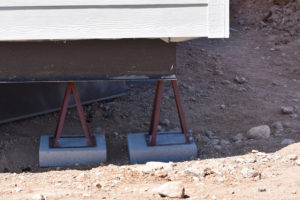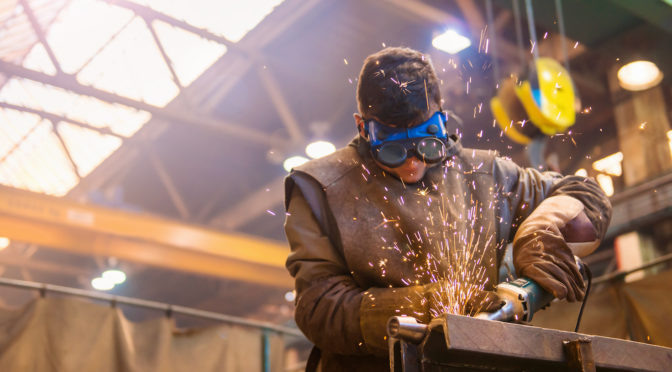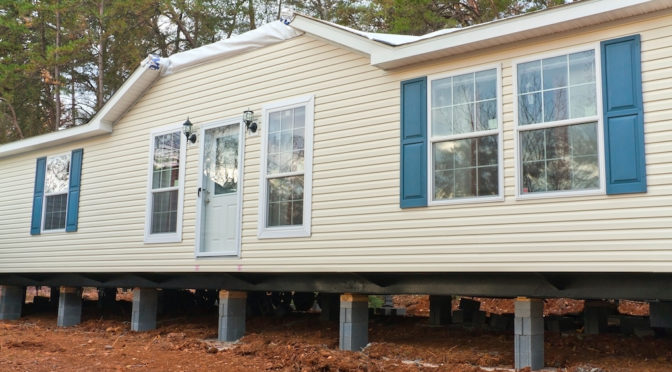How it Works – And Why it Works Well
 The unique construction process of a manufactured home is what sets it apart from site-built housing. Manufactured homes are built off-site in a specialized facility. The tools and technologies used in manufacturing facilities have grown leaps and bounds since mobile homes first went into production in the 1920s and 30s. Building techniques are constantly developing and improving, and standards and ever-increasing when it comes to safety and stability of a manufactured home. In today’s manufacturing facilities, a combination of state-of-the-art machinery and expert manual labor is used to build a sturdy home that meets strict standards and undergoes rigorous evaluation.
The unique construction process of a manufactured home is what sets it apart from site-built housing. Manufactured homes are built off-site in a specialized facility. The tools and technologies used in manufacturing facilities have grown leaps and bounds since mobile homes first went into production in the 1920s and 30s. Building techniques are constantly developing and improving, and standards and ever-increasing when it comes to safety and stability of a manufactured home. In today’s manufacturing facilities, a combination of state-of-the-art machinery and expert manual labor is used to build a sturdy home that meets strict standards and undergoes rigorous evaluation.
We’ll dive into some of the most important aspects of manufactured home construction, and then break down all of the components that go into a factory-built home.
HUD Building Code
The HUD code is a set of building regulations and standards put in place by the Department of U.S. Department of Housing and Urban Development. The code applies to all manufactured homes built after the year 1976, and updates are made as needed to strengthen safety standards and protect the residents of manufactured homes. For example, in the early 1990’s the HUD revised their building code to increase standards on wind and weather resistance, especially for manufactured homes in certain areas that are prone to hurricane-force winds.
The HUD Code plays a major role in the construction of manufactured homes, with rules related to every aspect of the building process from electrical and plumbing systems, to fire safety, to material waste management. When construction of a manufactured home is complete, each home is inspected first by the manufacturing facility, and then again by a third party, to certify that the home is up to HUD code regulation. Outside of construction, the HUD code also regulates other aspects of a manufactured home such as installation, maintenance, and even sales and distribution.
Benefits of a Controlled Environment
Building a home in a controlled environment has several advantages over constructing a site-built home outdoors. Manufacturing facilities can purchase certain items in bulk, such as materials, appliances, and windows, to get a better deal and cut costs. This works well for manufacturers, unlike traditional construction companies, because of the readily available, climate-controlled indoor storage at the building facility. Surplus items that aren’t needed right away can still be safely stored and used as needed without being exposed to the elements. Building in a stable environment with no wind and with level ground also allows for more precision and faster building time. Beams, walls, and floors can be joined together at precise angles with no disturbance, and there are no weather delays to worry about!
Manufactured Home Construction Process
While construction on a manufactured home may not literally happen from the “ground” up, there is a very precise and specific process that manufacturers go through to complete a HUD certified home. Building happens in different stages or stations, all within the same controlled factory setting, and multiple components of the home are worked on at the same time. Each individual task such as framing, plumbing, wiring, insulation, appliance installation, and joinery being completed by a crew of specialized experts who work only on the sections of the home they have been trained to master.
The process begins with innovative engineers designing the home to meet customer needs. Then, skilled laborers measure and cut wood and other materials for walls, roof sections and other components that will be put together to complete specific modules of the home. Walls are placed where they belong on their structural foundation according to the plans, floors are installed, and every angle is joined together perfectly. Other experts run electrical wires and plumbing systems, add thick insulation and drywall, and polish it off with appliances, fixtures, and finishings. A manufactured home can be swiftly and safely completed in much less time than a site-built home.
Quality manufactured home construction involves the following components:
Structure
Steel L-beams are connected to support the structure of your home, serving as the underlying frame for strength and stability.
Foundation
Once the frame is welded together and stabilized, it can be topped with decking and a thin layer of concrete to serve as the foundation. This foundation is designed to support the weight of the finished home, but to also withstand the stress of transportation to the home site. Once dry, this base foundation is ready to carry the weight of the wall framing and roof. This is also when installation begins for interior plumbing, air systems, fixtures, cabinets, and appliances.
Note: This foundation is different from the permanent or temporary foundation that your home will be placed upon once it arrives at the property. We dig further into foundation types below.
Sub-floor
Beneath the flooring of your home, a thick blanket of insulation is placed. This thermal padding will keep the home temperature regulated and make your home more energy-efficient. A specialized, reinforced vapor barrier is also placed in the underbelly below the flooring, which helps to keep out moisture, pests, and even allergens.
Plumbing System
A durable plumbing is installed as the other systems, insulation, and flooring of the home are put in place. Plumbing should always be placed within the insulation blanket below the flooring to help maintain consistent water temperatures. Layering the plumbing system into the insulation layer also helps prevent pipes from bursting due to extreme temperatures.
Flooring
Decking is placed beneath flooring and carpeting to provide extra stability. If possible, manufacturers and residents should avoid particle boards for floor decking and use a material of better quality instead. Water-resistant flooring in bathroom and kitchen areas should be standard, but always important to check.
Walls
Exterior wall construction involves using studs framed on 16” centers. This is a standard process across most manufacturers. Door and window openings are reinforced for added safety and durability. Once the exterior and interior wall frames are up, the interior of the walls is packed with thick insulation to ensure maximum climate control. The construction and insulation in the walls of your manufactured home are key to keeping your home comfortable and your energy bills low.
Electrical
Electrical wiring can be extremely dangerous if not completed correctly, which is why these systems are laid meticulously by electrical experts and rigorously reviewed by HUD code inspectors. All electrical wiring should be covered by steel plates and always pass through wall studs to ensure safety and prevent damage.
Roof
Structural lumber beams and ridge beams provide the structural integrity for the roof and create the hollow roof cavity. The roof cavity is then filled with insulation to help further reduce energy costs. Additional insulation or a roof cap can also be added to further regulate temperature energy.
Some manufactured homes have flat roofs, while others have angle roofs. Fiberglass shingles are the standard for construction, but PVC or rubber (EPDM) roofs are also common. Most manufacturers offer architectural shingles options or upgrades. The roof will be sealed and caulked, but releasing the roof is one of the important items to check and maintain on your home each year.
Exterior
House wraps can be installed to further reduce energy bills, and vinyl siding is the standard for many manufacturers due to its durability and low-maintenance.
Innovation Matters
Using computer-aided design and flexible machinery, manufacturers can also effortlessly change their floor plans, upgrade materials, and swap out features or accessories like appliances, storage, energy savers, and more.
After Construction
Wind and Weather Testing
After construction of a manufactured home is complete, each home is rigorously tested for extreme wind and weather conditions. Manufacturers build their homes according to the HUD standards for specific Wind Zones. The regulations for each Wind Zone determine not only how your home is constructed, but also how your home is anchored to the ground or foundation once on site. Wind testing has proven to be extremely effective, preparing manufactured homes for even the strong hurricane-force winds. In a study after four hurricanes hit Florida in 2004, it was discovered that not a single manufactured home built after the 1994 HUD code changes was completely destroyed.1
Transportation and Installation
 After construction, testing, and multiple inspections, a manufactured home is transported to the buyer’s property or site of choice. The home will be slid, pushed, or lifted into place on its temporary or permanent foundation and leveled. There are many different types of foundations, ranging from more basic pier-and-beam foundations, to helpful crawl spaces, to full-blown basement foundations. The recommended HUD ‘MH permanent foundation’ is just as strong of a foundation as is used in traditional site-built homes. A study of homes completed after hurricane Irma found that 25% of single family site-built homes were destroyed to the foundation, compared with only 20% of manufactured homes destroyed to that level.2
After construction, testing, and multiple inspections, a manufactured home is transported to the buyer’s property or site of choice. The home will be slid, pushed, or lifted into place on its temporary or permanent foundation and leveled. There are many different types of foundations, ranging from more basic pier-and-beam foundations, to helpful crawl spaces, to full-blown basement foundations. The recommended HUD ‘MH permanent foundation’ is just as strong of a foundation as is used in traditional site-built homes. A study of homes completed after hurricane Irma found that 25% of single family site-built homes were destroyed to the foundation, compared with only 20% of manufactured homes destroyed to that level.2
Despite the fact that the term “mobile home” is frequently used to describe manufactured homes, most of these homes are never moved again once they are set on their foundation. While moving the home is possible, it can be expensive and can risk damaging the home.
Anchoring
The way your home is anchored to the foundation is a crucial decision and can determine the safety and stability of your manufactured home. This will help prevent any shifting or stress that might occur from strong winds or seismic activity. Anchoring must comply with both the HUD code and manufacturer’s requirements, as well as local building code, so having a professional complete this task is essential. Many states have strict anchoring requirements that help ensure the home’s safety and durability.
Final Site Preparation
Once a manufactured home is placed on its foundation and anchored or tied down, it typically takes one or two weeks before the home is move-in ready for residents. The site will be busy with professionals connecting utilities, setting up systems, and adding finishing to connect and seal all components of the home. The manufactured home will typically receive one final, comprehensive inspection and evaluation before residents are able to move in.
Manufactured Home Construction Makes for Affordable Living
Construction is the key when it comes to providing safe, sturdy, affordable housing in the form of manufactured homes. The unique building techniques and streamlined processes used in manufacturing facilities make building a home faster and cost-effective, a benefit to both manufacturers and consumers. A controlled building environment makes precision and waste minimization easy. Strict HUD regulations and rigorous inspection ensure quality craftsmanship and customer satisfaction. And at the end of it all, residents come away with a reliable, wallet-friendly home they are proud to call their own.



